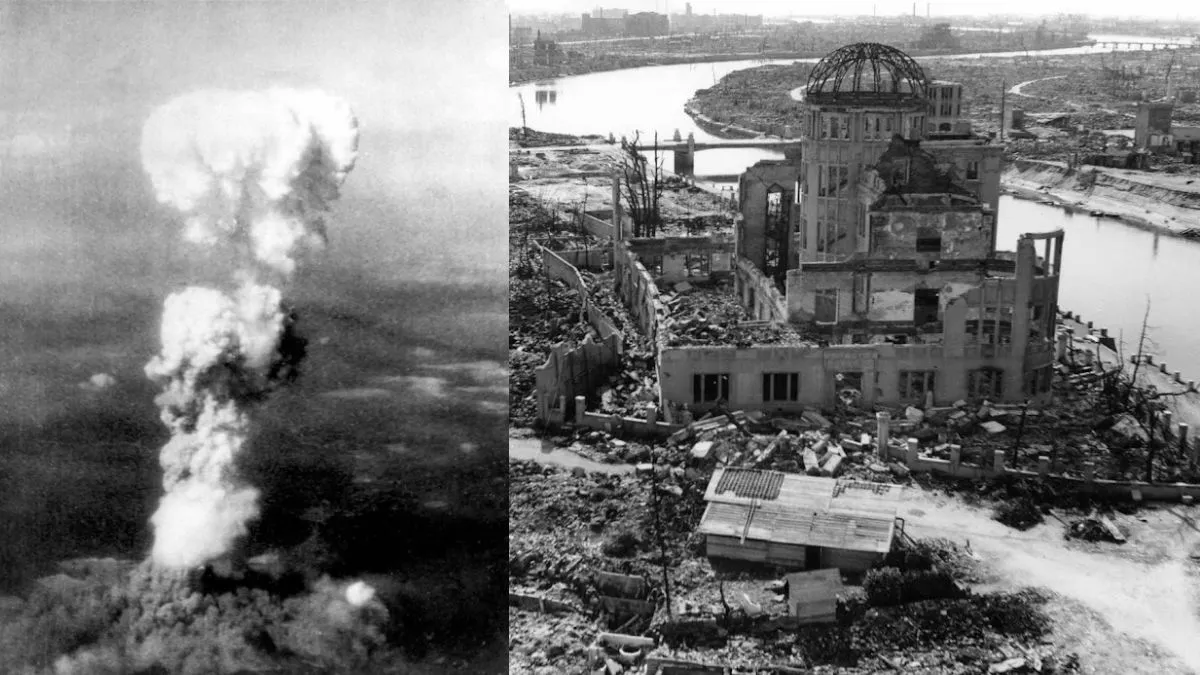Hiroshima Day 2025: Exactly 80 years after the world witnessed the horrors of nuclear war for the first time, thousands gathered in Hiroshima on Wednesday to remember the victims of the atomic bomb and to send a powerful message, the threat of nuclear conflict is rising again from Eastern Europe and the Middle East to South Asia. As thousands of people assembled in Hiroshima Peace Memorial Park at 8:15 a.m., the precise time the atomic bomb exploded on 6 August 1945, city mayor Kazumi Matsui cautioned that the warnings of history are being disregarded as international military build-up and nuclear modernisation gather pace.
As the iconic Peace Memorial Park held its annual commemoration, Hiroshima Mayor Kazumi Matsui warned of a disturbing global trend, the return of nuclear arms racing, military buildups, and renewed threats of atomic warfare, echoing the fears that birthed the global disarmament movement after World War II.“Among the world’s political leaders, there is a growing belief that possessing nuclear weapons is unavoidable to protect their own countries,” Matsui said. “This not only nullifies the lessons learned from Hiroshima and Nagasaki but also undermines the frameworks built for peace,” he added.
On August 6, 1945, an American B-29 bomber released a uranium bomb, codenamed “Little Boy,” onto Hiroshima, killing an estimated 78,000 individuals immediately. By year’s end, the count increased to 140,000. Three days after, “Fat Man”, a plutonium bomb, fell on Nagasaki and instantly killed 27,000 and approximately 70,000 by the end of the year. As of August 2024, Japan has formally acknowledged 344,306 deaths in Hiroshima and 198,785 in Nagasaki as a result of the bombings
How Nuclear Tensions Are Rising In 2025
Nine nuclear-armed countries have a total of an estimated 12,200 nuclear warheads, the equivalent of 146,500 Hiroshima bombs, with most available for launch on short notice. 90 per cent of the world’s arsenal is held by the United States and Russia. The US is in the middle of seven modernisation programmes, constructing two new nuclear facilities, and will spend USD 95 billion each year for the next ten years, the Congressional Budget Office estimated.
Russia-Ukraine War: A Constant Nuclear Shadow
Russia’s ongoing invasion of Ukraine continues to ratchet up international nuclear tensions. Following its halting of participation in the New START Treaty, Moscow has issued coded nuclear threats and deployed its tactical nuclear forces to Belarus. While Ukraine is not a nuclear state, the conflict has revived Cold War-era tensions and heightened the threat of nuclear escalation by mistake.
Israel-Gaza-Iran Tensions: Middle East Nuclear Flashpoint
In the Middle East, Israel, believed to have nuclear weapons, has conducted strikes on Iranian nuclear facilities. Iran insists its nuclear program is peaceful, but international skepticism remains. Ongoing conflicts in Gaza, combined with fears of a regional war, raise the risk of a nuclear flashpoint.
India-Pakistan: A Fragile Nuclear Rivalry
In South Asia, the nuclear-armed neighbors India and Pakistan continue to engage in border skirmishes and airspace violations. Both countries are modernizing their nuclear arsenals, with India developing longer-range delivery systems possibly aimed at China. Experts warn that conventional conflicts could quickly spiral into a nuclear crisis in this volatile region.
Arms competition, Treaty breakdowns, and AI threats
The breakdown of major nuclear arms treaties, the INF Treaty, Open Skies, and the Iran nuclear deal, has created increasing insecurity. The last big treaty between Russia and the US, the New START Treaty, is set to expire in February 2026, with no successor in the pipeline. The new technologies, such as AI, cyber warfare, and disinformation, could trigger unintended or automatic nuclear launches, particularly under high-tension situations. In the first half of 2025 alone, five nuclear-armed states, the US, Russia, India, Pakistan, and Israel, have been involved in direct conflicts or military hostilities. The growing distrust, disinformation, and cyberwarfare amplify the risk of catastrophic escalation.
Reflecting the seriousness of the world situation, the Bulletin of the Atomic Scientists has moved its symbolic Doomsday Clock to 89 seconds to midnight, closer than ever to worldwide catastrophe.
ALSO READ:US Moves Nuclear Subs After Ex-Russian President’s Cold War-Era Threat: How Arch Rivals Compete In Submarine Capabilities
UN Treaty And International Efforts
Though over 90 countries signed the UN Treaty on the Prohibition of Nuclear Weapons (TPNW), none of the existing nuclear nations — India, Pakistan, Israel, Russia, China, the US, UK, France, or North Korea have signed the treaty. Despite being the only country to have suffered nuclear attacks, Japan has not signed the UN Treaty on the Prohibition of Nuclear Weapons (TPNW). It remains under the US nuclear umbrella as part of its post-war security alliance. Critics argue this position weakens its moral stance on global disarmament.
ALSO READ: Russia Exits Cold War-Era Nuclear Treaty, Blames NATO And Trump’s Submarine Deployment
Eight decades after the first atomic bombing of the world, Hiroshima’s message is straightforward and timely, the world needs to choose between repeating history or learning from it. Mayor Matsui called on world leaders, “Please come and visit Hiroshima and see for yourselves the reality of the atomic bombing.” As tensions from Israel-Gaza and Russia-Ukraine escalate to India-Pakistan, and arms control treaties keep falling apart, the danger of nuclear war, mistake, misperception, or intent has never been greater.
